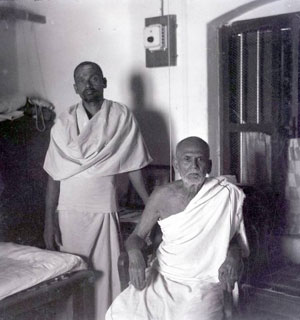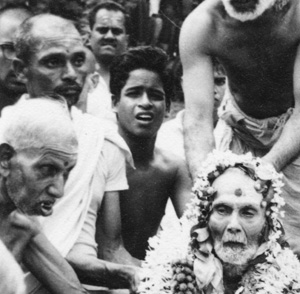
This article was originally posted in my blog on 13 May 2008.
In the early 1980s an English magazine called Arunachala Ramana appeared for a few years. During its brief lifespan several interesting items appeared on its pages which, to my knowledge, have not appeared elsewhere in the Ramana literature. I will add a few of these pieces to the blog over the next few days. The first is an interview which its editor. M. N. Baboo, had with Sadhu Om. It appeared in the February 1982 issue.
Question: When did you first hear of Sri Bhagavan?
Sadhu Om: In 1943, when I read Suddhananda Bharati’s book Sri Ramana Vijayam.
Question: When did you first see Bhagavan and what was your experience at that time?

Sadhu Om: I was able to come to Bhagavan only in 1945. When I entered the hall I wanted to see Bhagavan but I only saw a sofa and no one sitting on it. I was surprised to see, however, that everyone else was doing namaskarams towards that sofa. When I was hesitating whether to do namaskarams, I began to notice the vague outline of a human figure sitting on the sofa. At once I prostrated. When I got up, I saw that vague figure slowly solidifying and becoming clear. Then only was I able to recognise it as Sri Bhagavan.
On the next morning I sang before Sri Bhagavan the song Kuyilodu Koorai which I had composed while coming to him. He corrected one or two grammatical points in the song and asked me to show it to Muruganar. After coming to Bhagavan, there was a vast change and improvement in my poetic flow and style.
Question: How did Bhagavan look on Arunachala?
Sadhu Om: Bhagavan used to say, ‘Arunachala is jnanagni [the fire of jnana] in the form of a hill. It is Lord Siva Himself. Just as we identify our body as “I”, so Lord Siva, out of His compassion, identifies this hill as “I”. To live near Arunachala itself is satsang.’
Question: What sadhana did you follow?
Sadhu Om: Bhagavan taught two paths, self-enquiry and self-surrender. Just as it is natural for a man to walk on two legs, so it was natural for me to follow these two paths.
Question: What is the difference between the teachings of Sankara and Bhagavan?
Sadhu Om: Basically, they are one and the same. The only difference lies in the clues that they gave. Sankara and the ancient sastras said that self-enquiry is the path, but the only clues that they gave for the practice of self-enquiry were, ‘You are not the body, mind, etc., you are Brahman’. People failed to understand the purpose behind these clues, and so they started meditating, ‘I am not this, I am That’. In other words they were thinking only about ‘this’ and ‘that’, and were not attending to ‘I’. Therefore, knowing that people had misunderstood these ancient clues, Bhagavan, who is Sankara himself, has come again and given a simple clue: ‘Who am I?’ This is a positive and direct clue because in ‘Who am I? there is only ‘I’ and no ‘this’ or ‘that’. There is no room for us to think about things other than ‘I’. Thus Bhagavan has shown us a simple clue which will surely turn our attention only towards ‘I’. Attention to the mere feeling ‘I’ is the correct technique of self-enquiry.
Question: Among Bhagavan’s works, which do you consider the most important?
Sadhu Om: Ulladu Narpadu [Reality in Forty Verses].
Question: Would you please tell us some incidents that reveal the humour of Bhagavan?
Sadhu Om: Before standing up from the sofa Bhagavan used to rub ointment on his knees to relieve them from rheumatic stiffness. One day it was almost time for the dinner bell to ring, but Bhagavan had not started to rub the ointment on his knees. To remind him, the attendant took up his walking stick. Bhagavan smiled and said, ‘When the stick is waved, the monkey must dance’.
On another occasion a special puja was being conducted in the Mother’s Temple, and so the dinner was delayed. The poor people and sadhus, who are known as paradesis [outsiders] became impatient and began shouting, asking why their meals were delayed.
Seeing this commotion, the sarvadhikari [manager] ordered in a loud voice, ‘Paradesis will be fed only after the other people!’, and this was overheard by Bhagavan.
When finally the dinner bell rang, all the devotees gathered in the dining hall, but Bhagavan was nowhere to be seen. Everyone started searching for him and finally someone found him sitting under a tree in Palakottu [a garden to the West of the ashram where Bhagavan went for a walk almost every day].
When he was asked to come for dinner, Bhagavan replied, ‘No, not necessary. You may all take food without me.’
This was reported to the sarvadhikari who at once sent two doctor devotees to Bhagavan, thinking that he was perhaps not well. When Bhagavan told the doctors that nothing was wrong with his health, they asked him why he was not coming for food.
‘It has been ordered that paradesis will be fed afterwards. I am also a paradesi [an outsider]. So let the swadesis [the people who belong here] take their food first. Afterwards, I will take food along with the other paradesis.’
On hearing this the sarvadhikari at once ordered that the paradesis should be fed first. Only then did Bhagavan come to the dining room. From that day onwards, the paradesis were always served first.
[There is a play on words here that is not fully brought out in this recorded answer. Bhagavan definitely did belong to the ashram, and would not consider himself to be an outsider there. However, the word paradesi is also used to denote sannyasins and sadhus. To emphasise the point that people should not be discriminated against when food was being served, Bhagavan chose to identify himself on this occasion as a sadhu, not an outsider.]

Question: Can you tell me about any miracles performed by Bhagavan?
Sadhu Om: Whenever devotees told Bhagavan that he had performed a miracle, he always denied it because he had no sense of doership. However, many miracles used to happen in his presence, and he once explained that they were all ‘automatic divine activity’. Almost every devotee can tell you of some miracle that happened to them.
Question: So please tell us about at least two miracles that happened.
Sadhu Om: When he was a baby, a devotee called Amritalingam was found to have a liver tumour. Therefore, his mother, Mrs C. P. Nathan, took him to Bhagavan and said, ‘Bhagavan, the doctors say that he has a liver tumour and that it cannot be cured’.
Bhagavan then touched the baby’s belly and remarked, ‘Who said so? Nothing is found here?’
After that, all signs of the tumour disappeared.
On another occasion a devotee whose ishta deva [chosen deity] was Lord Subrahmanya, came to Bhagavan and reported, ‘I was in hospital and suffering from a critical disease. The doctors had decided that there was no hope for me. One night, while I was wide awake, you came and sat by my bed and said some kind words to me. The next day I began to recover, and now I am back to normal. It is all due to your grace.’
Bhagavan smiled and said, ‘Because of your devotion to Lord Subrahmanya, he had to come to save your life. But see! Why did he appear in my form, instead of his own? Because of this, you now attribute the miracle to me.’
Question: Please tell us about Bhagavan’s forbearance of suffering during his cancer operations.
Sadhu Om: Even at the time of his fourth operation, which was a very major one, Bhagavan refused to be given chloroform. The operation took a long time, and because of the profuse bleeding, it was very difficult for the doctors to dress the wound. Towards the end of the operation Bhagavan was talking to someone when the doctors informed him that the operation was over.
‘What! Is it over?’ asked Bhagavan.
Someone then asked, ‘Bhagavan, did you not feel any pain?’
Bhagavan replied, ‘Yes, there was pain, like a hundred chillies being ground in the wound, but even that pain is not apart from me.’
On another occasion, talking about the cancer, Bhagavan said, ‘The body itself is a disease. If another disease comes to this first disease, is it not good for us?’
Question: Did anyone predict the birth of Bhagavan?
Sadhu Om: Ramalinga Swami [a 19th century Tamil saint] sang in verse, shortly before he passed away [in 1877] ‘O men, the time is fast approaching when my Lord [Siva] will come on earth’. Vivekananda also predicted in 1898 that a great Atma-jyoti [light of the Self] was now springing up in Tamil Nadu.
Question: Did you see the jyoti [light] at the time of Bhagavan’s nirvana?
Sadhu Om: We were sitting in the Mathrubhuteswara veranda singing Aksharamanamalai, when all of a sudden we saw a bright flash from the nirvana room where Bhagavan lay. We thought at first that it was a camera flashlight. But at the same time people in the open began shouting ‘Jyoti! Jyoti in the sky!’ because they saw a big light in the sky, which then slowly moved northwards and disappeared behind Arunachala.